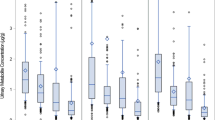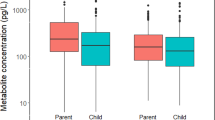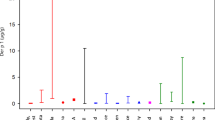Abstract
In the summer of 1997, we measured the aggregate exposures of nine preschool children, aged 2–5 years, to a suite of organic pesticides and other persistent organic pollutants that are commonly found in the home and school environment. The children attended either of two child day care centers in the Raleigh–Durham–Chapel Hill area of North Carolina and were in day care at least 25 h/week. Over a 48-h period, we sampled indoor and outdoor air, play area soil and floor dust, as well as duplicate diets, hand surface wipes, and urine for each child at day care and at home. Our target analytes were several polycyclic aromatic hydrocarbons (PAH), organochlorine pesticides, and polychlorinated biphenyls (PCB); two organophosphate pesticides (chlorpyrifos and diazinon), the lawn herbicide 2,4-dichlorophenoxyacetic acid (2,4-D), three phenols (pentachlorophenol (PCP), nonyl phenols, and bisphenol-A), 3,5,6-trichloro-2-pyridinol (TCP), and two phthalate esters (benzylbutyl and dibutyl phthalate). In urine, our target analytes were hydroxy-PAH, TCP, 2,4-D, and PCP. To allow estimation of each child's aggregate exposures over the 48-h sampling period, we also used time–activity diaries, which were filled out by each child's teacher at day care and the parent or other primary caregiver at home. In addition, we collected detailed household information that related to potential sources of exposure, such as pesticide use or smoking habits, through questionnaires and field observation. We found that the indoor exposures were greater than those outdoors, that exposures at day care and at home were of similar magnitudes, and that diet contributed greatly to the exposures. The children's potential aggregate doses, calculated from our data, were generally well below established reference doses (RfDs) for those compounds for which RfDs are available.
This is a preview of subscription content, access via your institution
Access options
Subscribe to this journal
Receive 6 print issues and online access
$259.00 per year
only $43.17 per issue
Buy this article
- Purchase on Springer Link
- Instant access to full article PDF
Prices may be subject to local taxes which are calculated during checkout




Similar content being viewed by others
References
Acheson K.J., Campbell I.T., Edholm O.G., Miller D.S. and Stock M.J. The measurement of food and energy intake in man — an evaluation of some techniques. Am J Clin Nutr 1980: 33: 1147–1154.
ASTM — Standard practice for collection of floor dust for chemical analysis D5438-94. Annual Book of ASTM Standards, Vol. 11.03. American Society for Testing and Materials, West Conshohoken, Pennsylvania, 1997, pp. 517–523.
Ballauf A., Kersting M. and Manz F. Do children have an adequate fluid intake? Water balance studies carried out at home. Ann Nutr Metab 1988: 32: 332–339.
Bernard C.E. Nuygen H. Truong D. and Krieger R.I. Environmental residues and biomonitoring estimates of human insecticide exposure from treated residential turf. Arch Environ Contam Toxicol 2001: 41 (2): 237–240.
Block G. A review of validations of dietary exposure assessment methods. Am J Epidemiol 1982: 115: 492–505.
Chuang J.C., Brinkman M., Hart K., Davis D.B., Finegold J. and Gordon S.M. Method refinement and analysis of food data. Report to USEPA, Contract 68-D4-0023, WA 4-03, 1999a.
Chuang J.C., Callahan P.J., Lyu C.W. and Wilson N.K. Polycyclic aromatic hydrocarbon exposures of children in low-income families. J Expos Anal Environ Epidemiol 1999b: 9: 8598.
Chuang J.C., Callahan P.J., Menton R.G., Gordon S.M., Lewis R.G. and Wilson N.K. Monitoring methods for polycyclic aromatic hydrocarbons and their distribution in house dust and track-in soil. Environ Sci Technol. 1995: 29: 494–500.
Chuang J.C., Gordon S.M., Roberts J.W., Han W. and Ruby M.G. Evaluation of HVS3 sampler for sampling polycyclic aromatic hydrocarbons and polychlorinated biphenyls. EPA/600/R-94/188, 1994.
Chuang J.C., Hannan S.W. and Wilson N.K. Field comparison of polyurethane foam and XAD–2 resin for air sampling for polynuclear aromatic hydrocarbons. Environ Sci Technol 1987: 21: 798–804.
Chuang J.C., Lyu C., Chou Y-L., Callahan P.J., Nishioka M., Andrews K., Pollard M.A., Brackney L., Hines C., Davis D.B. and Menton R. Evaluation and application of methods for estimating children's exposure to persistent organic pollutants in multiple media. EPA 600/R-98/164a, 164b, and 164c, 1998.
Chuang J.C., Mack G.A., Kuhlman M.R. and Wilson N.K. Polycyclic aromatic hydrocarbons and their derivatives in indoor and outdoor air in an eight-home pilot study. Atmos Environ 1991: 25B: 369–380.
Chuang J.C., Wilson N.K. and Lewis R.G. Methodology of ambient monitoring for polycyclic aromatic hydrocarbons. Fresenius Environ Bull 1999c: 8: 547–556.
Cohen Hubal E.A., Sheldon L.S., McCurdy T.R., Rigas M.L., Burke J.M. and Zartarian V.G. Children's exposure assessment: a review of factors influencing children's exposure, and the data available to characterize and assess that exposure. Environ Health Perspect 2000a: 108 (6): 475–486.
Cohen Hubal E.A., Sheldon L.S., Zufall M.J., Burke J.M. and Thomas K.W. The challenge of assessing children's residential exposure to pesticides. J Expos Anal Environ Epidemiol 2000b: 10: 638–649.
Curl C.L., Fenske R.A., Kissel J.C., Shirai J.H., Moate T.F., Griffith W., Coronado G. and Thompson B. Evaluation of take-home organophosphorus pesticide exposure among agricultural workers and their children. Environ Health Perspect 2002: 110: 787–792.
Driver J.H., Konz J.J. and Whitmyre G.K. Soil adherence to human skin. Bull Environ Contam Toxicol 1989: 43: 814–820.
Duggan M.J., Inskip M.J., Rudle S.A. and Moorcroft J.S. Lead in playground dust and on the hands of schoolchildren. Sci Total Environ. 1985: 44: 65–79.
EFH — Exposure Factors Handbook, US Environmental Protection Agency, Office of Health and Environmental Assessment, Washington DC. EPA 600/P-95/Fa, b, and c, 1995. http://cfpub.epa.gov/ncea/cfm/efprog.cfm?ActType=default.
Fennema O.R. and Anderson S.A. In: Monitoring Dietary Intakes. Macdonald I. (Ed). Springer-Verlag, Berlin, 1991, p. 45.
Fenske R.A. and Elkner K.P. Multi-route exposure assessment and biological monitoring of urban pesticide applicators during structural control treatments with chlorpyrifos. Toxicol Ind Health 1990: 6: 349–371.
Fenske R.A., Kedan G., Lu C., Fisker-Andersen J.A. and Curl C.L. Assessment of organophosphate pesticide exposures in the diets of preschool children in Washington State. J Expos Anal Environ Epidemiol 2002a: 12: 21–28.
Fenske R.A., Lu C., Barr D. and Needham L. Children's exposure to chlorpyrifos and parathion in an agricultural community in central Washington State. Environ Health Perspect 2002b: 110: 549–553.
Fenske R.A., Lu C., Simcox N.J., Loewenherz C., Touchstone J., Moate T.F., Allen E.H. and Kissel J.C. Strategies for assessing children's organophosphorus pesticide exposures in agricultural communities. J Expos Anal Environ Epidemiol 2000: 10: 662–671.
Freeman N.C.G., Sheldon L., Jiminez M., Melnyk L., Pellizzari E. and Berry M. Contribution of children's activities to lead contamination of food. J Expos Anal Environ Epidemiol 2001a: 11: 407–413.
Freeman N.C.G., Jiminez M., Reed K.J., Gurunathan S., Edwards R.D., Roy A., Adgate J.L., Pellizzari E.D., Quackenboss J., Sexton K. and Lioy P.J. Quantitative analysis of children's microactivity patterns: The Minnesota Children's Pesticide Exposure Study. J Expos Anal Environ Epidemiol 2001b: 11: 501–509.
Gordon S.M., Callahan P.J., Nishioka M.G., Brinkman M.C., O'Rourke M.K., Lebowitz M.D. and Moschandreas D.J. Residential environmental measurements in the national human exposure assessment survey (NHEXAS) pilot study in Arizona: preliminary results for pesticides and VOCs. J Expos Anal Environ Epidemiol 1999: 9: 456–470.
Griffin P., Mason H., Heywood K. and Cocker J. Oral and dermal absorption of chlorpyrifos: a human volunteer study. Occup Environ Med 1999: 56: 10–13.
Gurunathan S., Robson M., Freeman N., Buckley B., Roy A., Meyer R., Bukowski J. and Lioy P.J. Accumulation of chlorpyrifos on residential surfaces and toys accessible to children. Environ Health Perspect 1998: 106: 9–16.
Heil M., Schilter B., Huggett A.C. and Haschke F. Toxicological aspects of food for infants and children. Monatsschrift Kinderheilkunde 1996: 144 (Suppl. 2): S224–S229.
IARC — Monographs on the evaluation of the carcinogenic risk of chemicals to Humans. International Agency for Research on Cancer (IARC), Lyon, France 1997
IRIS — EPA's Integrated risk information system 〈www.epa.gov/ngispgm3/iris/index.html〉. 1999.
Koch D., Lu C., Fisker-Andersen J.A., Jolley L. and Fenske R.A. Temporal association of children's pesticide exposure and agricultural spraying: report of a longitudinal biological monitoring study. Environ Health Perspect 2002: 110: 829–833.
Landrigan P.J., Claudio L., Markowitz S.B., Berkowitz G.S., Brenner B.L., Romero H., Wetmer J.G., Matte T.D., Gore A.C., Godbold J.H. and Wolff M.S. Pesticides and inner-city children: exposures, risks, and prevention. Environ Health Perspect 1999: 107 (Suppl. 3): 431–437.
Lewis R.G., Fortmann R.C. and Camann D.E. Evaluation of methods for monitoring the potential exposure of small children to pesticides in the residential environment. Arch Environ Contam Toxicol 1994: 26: 37–46.
Lewis R.G., Fortune C.R., Willis R.D., Camann D.E. and Antley J.T. Distribution of pesticides and polycyclic aromatic hydrocarbons in house dust as a function of particle size. Environ Health Perspect. 1999: 107: 721–726.
Lu C. and Fenske R.A. Dermal transfer of chlorpyrifos residues from residential surfaces: comparison of hand press, hand drag, wipe, and polyurethane foam roller measurements after broadcast and aerosol pesticide applications. Environ Health Perspect. 1999: 107: 463–467.
MacIntosh D.L., Kabiru C., Echols S.L. and Ryan P.B. Dietary exposure to chlorpyrifos and levels of 3,5,6-trichloro-2-pyridinol in urine. J Expos Anal Environ Epidemiol 2001: 11: 279–285.
Menzie C.A., Potocki B.B. and Santodonato Z.J. Exposure to carcinogenic PAH in the environment. Environ Sci Technol 1992: 26: 1278–1284.
Miller L.A. and Stapleton F.B. Urinary volume in children with urolithiasis. J Urol 1989: 141: 918–920.
Morgan M., Sheldon L., Wilson N., Chuang J., Junod N., Brinkman M. and Lyu C. Levels of organochlorine, organophosphorus, and pyrethroid pesticides in CTEPP North Carolina multimedia samples. Presented in the Symposium on “Young Children's Exposures to Persistent Organic Pollutants” at the joint meeting of the International Society of Exposure Analysis and the International Society for Environmental Epidemiology, Vancouver, BC, August 2002.
Mukerjee D. Assessment of risk from multimedia exposures of children to environmental chemicals. J Air & Waste Manage Assoc 1998: 48: 483–501.
Ny E.T., Heederik D., Kromhout F. and Jongeneelen F. The relationship between polycyclic aromatic hydrocarbons in air and urine of workers in a Soderberg potroom. Am Ind Hyg Assoc J 1993: 54: 277–284.
ORD Research Abstract — Pilot study on children's total exposure to persistent pesticides and other pollutants (CTEPP). USEPA Office of Research and Development, Washington DC, April 2000.
O'Rourke M.K., Lizardi P.S., Rogan S.P., Freeman N.C., Aguirre A. and Saint C.G. Pesticide exposure and creatinine variation among young children. J Expos Anal Environ Epidemiol 2000: 10: 672–681.
Que Hee S.S., Peace B., Clark C.S., Boyel J.R., Bornschein R.L. and Hammond P.B. Evolution of efficient methods to sample lead sources, such as house dust and hand dust, in the homes of children. Environ Res. 1985: 38: 77–95.
Stanek III E.J. and Calabrese E.J. Daily estimates of soil ingestion in children. Environ Health Perspect 1995a: 103: 276–285.
Stanek III E.J. and Calabrese E.J. Soil ingestion estimates for use in site evaluations based on the best tracer method. Human and Ecological Risk Assessment 1995b: 1: 133–156.
Szabo L. and Fegyverneki S. Maximum and average urine flow rates in normal children — the Miskolc nomograms. Br J Urol 1995: 76: 16–20.
Tulve N.S., Suggs J.C., McCurdy T., Cohen Hubal E.A. and Moya J. Frequency of mouthing behavior in young children. J Expos Anal Environ Epidemiol 2002: 12: 259–264.
Waldman J.M., Lioy P.L., Greenberg A. and Butler J.P. Analysis of human exposure to benzo[a]pyrene via inhalation and food ingestion in the total human environment exposure study (THEES). J Expos Anal Environ Epidemiol 1991: 1: 193–225.
Wania F. and MacKay D. Tracking the distribution of persistent organic pollutants. Environ Sci Technol 1996: 30: 390A–396A.
WIC (Women, Infants, and Children). 1997: http://www.fns.usda.gov/wic.
Wilson N.K., Chuang J.C. and Kuhlman M.R. Sampling polycyclic aromatic hydrocarbons and related semivolatile organic compounds in indoor air. Indoor Air 1991: 4: 513–521.
Wilson N.K., Chuang J.C. and Lyu C. Evaluation of field methods for estimating exposure of children in low-income families to polycyclic aromatic hydrocarbons. Measurement of Toxic and Related Air Pollutants, Air and Waste Management Association, Pittsburgh, Pennsylvania. 1996: VIP64: pp. 797–802.
Wilson N.K., Chuang J.C. and Lyu C. Multimedia concentrations of PAH in several day care centers. Polycyclic Aromat Compd 1999: 17: 255–265.
Wilson N.K., Chuang J.C. and Lyu C. PAH exposures of nine preschool children. Polycyclic Aromat Compd 2000: 21: 247–259.
Wilson N.K., Chuang, J.C. and Lyu C. Levels of persistent organic pollutants in several child day care centers. J Expos Anal Environ Epidemiol 2001: 11: 449–458.
Wilson N.K. Iachen R. Chuang J.C. Gordon S.M. Feder P. Strauss W. Evans G.F. Özkaynak H. Sheldon L.S. and Morgan M.K. Children's total exposures to persistent pesticides and other persistent organic pollutants (CTEPP): An overview. Presented in the Symposium on Young Children's Exposures to Persistent Organic Pollutants at the joint meeting of the International Society of Exposure Analysis and the International Society for Environmental Epidemiology, Vancouver, BC, August 2002.
Zahm S.H. and Devesa S. Childhood cancer: overview of incidence trends and environmental carcinogens. Environ Health Perspect 1995: 103 (Suppl. 6): 177–184.
Acknowledgements
We thank Ying-Liang Chou, Patrick J. Callahan, Marcia Nishioka, Kimberlea Andrews, Mary A. Pollard, Laura Brackney, Charles Hines, Dave B. Davis, and Sydney Gordon for their contributions to this study. The research described in this article has been funded wholly or in part by the United States Environmental Protection Agency through Contract 68-D4-0023 to Battelle. It has been subjected to Agency review and approved for publication. Mention of trade names or commercial products does not constitute an endorsement or recommendation for use.
Author information
Authors and Affiliations
Corresponding author
Rights and permissions
About this article
Cite this article
Wilson, N., Chuang, J., Lyu, C. et al. Aggregate exposures of nine preschool children to persistent organic pollutants at day care and at home. J Expo Sci Environ Epidemiol 13, 187–202 (2003). https://doi.org/10.1038/sj.jea.7500270
Received:
Accepted:
Published:
Issue Date:
DOI: https://doi.org/10.1038/sj.jea.7500270
Keywords
This article is cited by
-
Pesticide, allergen, PCB, and lead measurements in childcare centers located on tribal lands in the Pacific Northwest, United States
Journal of Exposure Science & Environmental Epidemiology (2023)
-
Assessment of Preschool Children’s Exposure Levels to Organophosphate and Pyrethroid Pesticide: A Human Biomonitoring Study in Two Turkish Provinces
Archives of Environmental Contamination and Toxicology (2023)
-
Development and evaluation of a novel dietary bisphenol A (BPA) exposure risk tool
BMC Nutrition (2022)
-
Body fluids from the rat exposed to chlorpyrifos induce cytotoxicity against the corresponding tissue−derived cells in vitro
BMC Pharmacology and Toxicology (2021)
-
Herbicides based on 2,4-D: its behavior in agricultural environments and microbial biodegradation aspects. A review
Environmental Science and Pollution Research (2020)



